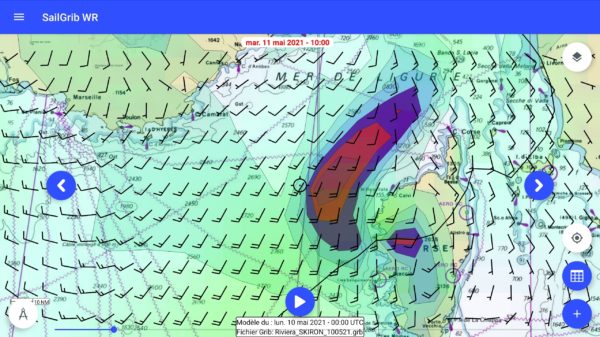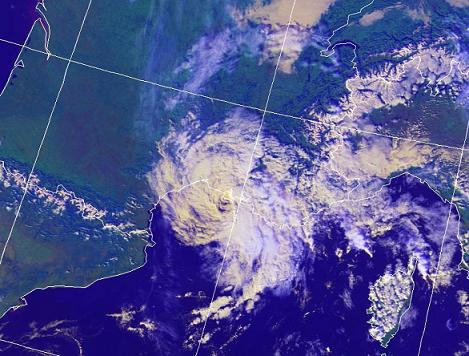The many sailors who crisscross the "Big Blue" have known for ages that, if the navigation is relatively easy, meteorology represents a particularly difficult constraint to apprehend. Indeed, if the coasts are mostly steep and the dangers very localized, if the tides are almost negligible, if the currents are only to be taken into account in well-defined areas, the major difficulty comes from a capricious meteorology, difficult to predict, can represent a real danger by his changing moods, sudden, even brutal.
Introduction
The Mediterranean is indeed a sea apart. Completely surrounded by an alternation of mountainous reliefs and desert plains, steep capes and long beaches, dotted with many large islands and mostly steep coasts, it is subject to the coastal effects of strong thermal breezes, katabatic winds, and various local aerological phenomena that combine with general meteorological conditions linked to the movements and conflicts of the air masses that sweep over it. A real headache for meteorologists, and even more for navigators from Ulysses and Phoenician merchants !
Fortunately, meteorological science has advanced considerably, and high-resolution models provide excellent medium-term predictions, that is to say at maturity of 3 up to 4 days. This is perfectly sufficient since we rarely spend more than 48 hours at sea to cross it from one coast to another. We can usefully use the model ARPEGE up to 4 days of Météo-France which covers the entire Mediterranean with a resolution of 6 nautical miles. We will complete for short distances with the models AROME up to 36-42 hours and very high resolution (1,5 MN), covering the western basin of France to the south of Sardinia and the Balearic Islands.
For the central and eastern part, either from the Tyrrhenian Sea to Turkey, we can use the many WRF models offered by the website OpenSkiron (¹) with resolutions ranging from 12 km to 4 km. We will not forget to stay on standby and listen to local radio alerts concerning very localized phenomena.
Among these phenomena, there is one to which we must be particularly attentive, because extremely dangerous : charts portfolio medicane.
The medicane
The term "medicane" is the contraction of " Mediterranean Hurricane ". Medicanes are subtropical depressions that can form when the sea surface is strongly warmed in summer., causing storm winds and heavy precipitation (²). When the water temperature occasionally exceeds 25-26 ° C, it can develop significant convective energy at the base of a hot and humid air mass, thus supplying a low pressure system with characteristics equivalent to tropical cyclones. An eye is sometimes visible and the weather phenomena they cause are particularly violent.
They are actually hybrid depressions, driven by "tropical" type processes such as the release of latent heat by convection, and of the "extra-tropical" type such as the horizontal thermal contrasts. As such, we speak more precisely of "subtropical cyclones " because these are not hurricanes in the true sense of the word.
Genesis of the Medicanes
(³) The criteria and initial states most often required for the formation of a tropical system are as follows :
- Underlying sea temperature above 25-26 ° C to a depth of at least 50 meters.
- Unstable air mass = strong CAPE (⁵)
- High humidity in the lower and middle layers of the atmosphere
- Beginning of prior disturbance in the lower layers at sea level
- Low shear (change in force or direction) wind with altitude
- Overlying cold air mass in the upper layers
These initial conditions are quite often created by the arrival on the sea of a mass of air warmed by high temperatures on the land., in certain favorable places of the Mediterranean rim, and that, thrust at sea by a conjunction of factors - orientation of pressure fields, synoptic wind, coriolis force, for example - takes care of humidity on superheated water with high evaporation. It is often observed between the plains of southeastern Spain and the Balearic Islands, between the Maghreb and Sardinia, or between Libya and Sicily or Greece. Risks are increased from mid-summer until early winter, period when the sea becomes the hottest and remains so for a long time because of its great thermal inertia.
More and more frequent
Medicanes are not new phenomena. It has been observed episodically since satellite measurements have existed.. Until 2015, we counted one every 2 up to 5 years on average. but in recent years there has been an increase in the frequency of medicanes from mid-summer to late autumn, which confirms the increasing probability that this phenomenon will become recurrent with global warming, like the Mediterranean rainy episodes (Cevennes episodes).
France has already experienced this phenomenon in the past. The last date of 6 at 9 November 2011. "Rolf" particularly affected the coast of the Var and the Alpes-Maritimes. He fell 250 mm of rain in less than 48 hours to Bormes-les-Mimosas, dont 115 mm en 12 hours only. The gusts of wind reached 85 nodes in Saint-Raphaël and 83 nodes in Hyères (⁴).
More recently, Greece was struck on the night of 18 at 19 September, 2020 by strong winds and heavy rains from medicane "Ianos". These caused flooding in the southern part of the country, from the Peloponnese to the center-east. The strongest winds reached on average the 60 nodes with gusts locally greater than 85 nodes over the Ionian Islands and in particular the Kefalonia Islands, Lefkada and Zakynthos. This system also caused waves of over 5 meters offshore. In addition, torrential rains accompanied this episode of bad weather with 100 up to 200 mm measured over large areas and locally up to 400 mm on the foothills of the mountains of central Greece and the Peloponnese. The damage to pleasure craft was considerable.
From 11 at 15 November 2021 the medicane "Blas" made a surprising trajectory in the south of the western basin, and of an exceptional duration of more than 5 days, with intermittent pressure dips as it travels. Unfortunately, I did not capture the end of the phenomenon. But he went up along Sardinia to reach the Ligurian Sea on 15 November, with bursts of 60 up to 70 nodes between Corsica and the French Riviera.
How to forecast and anticipate
With weather models in GRIB format, it is imperative to display the CAPE (⁵) to measure the level of instability of the air mass. It is also necessary to display the isobars with a reduced spacing (2 hPa) with a model like AROME or a WRF to 4 km. We can thus better see the appearance of a low pressure level during digging and follow the prediction of its evolution. Attention, a model like the GFS, even with 0.25 ° resolution, is not relevant enough to see this type of phenomenon. On the other hand, the German DWD's ICON EU model proved to be, for medicane Ianos, much more precise than the ARPEGE model, anticipating well before him the power and the real course of the storm. It is therefore appropriate, as the most careful boaters have done, to anticipate according to the most pessimistic model to take shelter.
–––
(¹) Open Skiron
(²) We also talk about T.M.S. (Tropical-like Mediterranean Storm).
(³) Source : Lionel peyraud 8/11/2011
(⁴) Source : Keraunos
(⁵) CAPE : read Forecasting thunderstorms with Weather4D
–––





